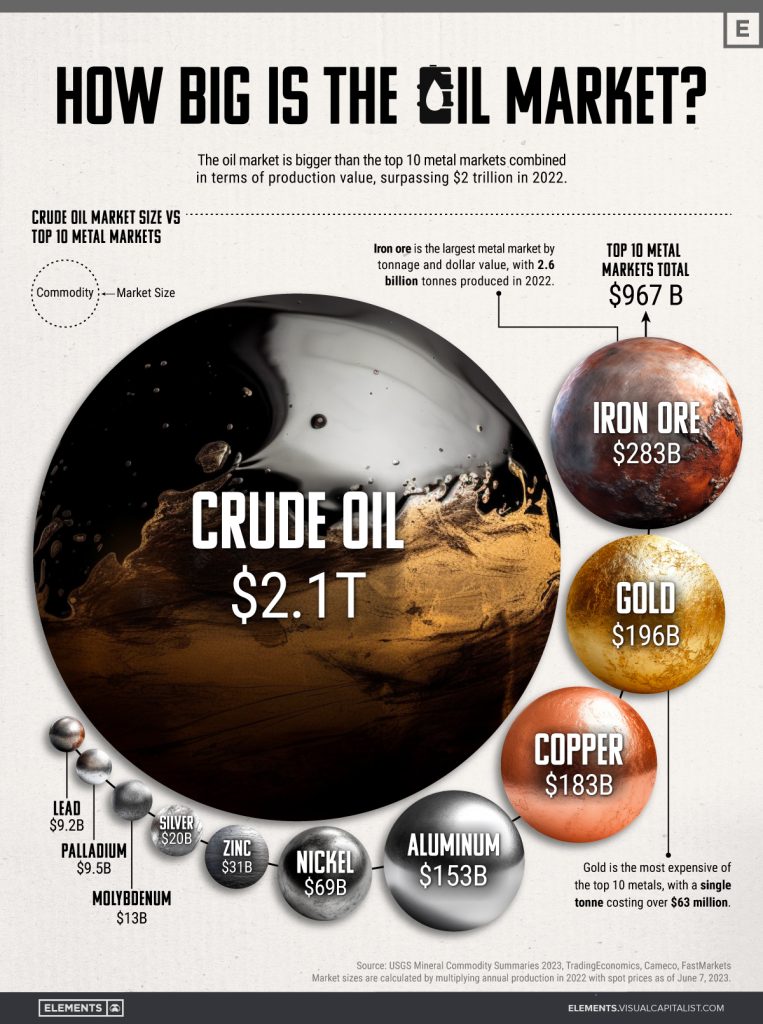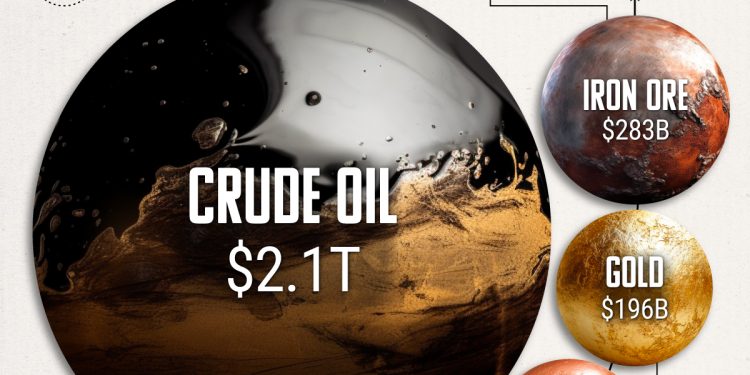Last week we took a brief look at the global markets and macroeconomic indicators and the message, after a careful review of those, was clear: global economy isn’t creating much activity and therefore multiple indicators are either down or heading in that direction. This week I wanted to highlight the latest developments in oil markets as the commodity remains the most strategic one lubricating the global factory. The following infographic by Visual Capitalist puts this into perspective.

In the year 2022, global production of oil averaged 80.75 million barrels daily, taking into account condensates. This translates to an approximate annual output of crude oil of 29.5 billion barrels. With the prevailing prices during that period, the market valuation surpassed the $2 trillion mark. The aggregate market value of the top 10 metal markets is $967 billion, which is less than half of the oil market’s size. Interestingly, the oil market continues to dwarf the combined value of these top metal markets even when all the additional, smaller raw metal markets are factored in.
Lately, the oil markets have been trying to decide what version of the story they should believe in. There are essentially two of them. The first version highlights the supply risks and see a spike in prices as global economy recovers meanwhile the slow pace of new oil and gas developments lag behind. The second version, on the contrary, provides a different story one that emphasizes the fact that global economy seems to be slowing down so the aforesaid risk is invalid at least in the shorter term. Moreover, a look at the physical oil markets show no shortage of supply rather the opposite of that therefore prices will head lower as markets are in oversupply or well supplied (whichever you want to prefer).
Mark Rossano has mentioned this in one of his recent Insights. He mentions how crude oil in transit has reached an all-time high in 2023, with an unprecedented amount currently being transported on water. Concurrently, floating storage levels have also hit seasonal records, only surpassed by the figures from 2016. This surge can be attributed to the growing influx of crude oil into the global market, with Russia attempting to maintain its existing flows while Iran seeks to increase its production volumes.
Global Crude Oil on Water

We are currently observing a slowdown in the pricing of physical crude, particularly originating from Nigeria. The country is facing a significant accumulation of unsold Nigerian oil, with nearly half of the upcoming month’s output still searching for buyers due to a decline in market confidence caused by the nation’s tax clawback. This surplus indicates that the global oil supply reductions implemented by major producer nations have not yet sufficiently tightened every market. According to West African crude traders, there are approximately 20 to 22 cargoes for July that remain unsold, accounting for about half of the total.
A recent survey by Reuters also stresses upon the prevailing/growing bearish sentiment in the oil markets.
According to a recent survey of 37 economists and analysts, the average forecast for Brent crude in 2023 has been revised down to $83.03 per barrel, compared to the consensus of $84.73 in May.
Currently trading around $75 per barrel, with a decline of approximately 13% so far this year, the global benchmark is expected to average $83.28 in the third quarter before surpassing the $86 mark in the following two quarters.
Projections for U.S. crude have also been adjusted downward to $78.38 per barrel for 2023, down from last month’s estimate of $79.20.
The upcoming third quarter is crucial as it will determine whether the optimistic demand growth forecasts from OPEC and the International Energy Agency (IEA) can materialize, thereby avoiding further downward pressure on prices, according to Ole Hansen, Saxo Bank’s head of commodity strategy.
Goldman Sachs has recently highlighted that rising interest rates will continue to exert a persistent drag on oil prices.

While increasing rates and weaker economic indicators from China have weighed on oil markets, some analysts anticipate a modest boost in prices from stimulus measures and the supply curtailments led by Saudi Arabia under the OPEC+ agreement.
Notably, the International Energy Agency (IEA) has expressed a positive outlook, stating that the OPEC+ output deal significantly improves the prospects of higher prices. Additionally, Saudi Aramco has predicted that demand from China and India will offset recession risks in developed countries. However, that can change if the world enters a global recession.
According to John Kemp, the total combined position stood at 346 million barrels. Notably, this figure remained relatively stable, showing minimal change from the 350 million barrels recorded on March 28, coinciding with the eruption of the U.S. regional banking crisis. Despite the production cuts announced by Saudi Arabia and its OPEC+ allies, there has been no significant and enduring shift in these positions.

More by John Kemp:

All in all the oil markets are poised in a way that the prices can go either direction. However, given the orientation of the global economy as highlighted by the macro indicators that I covered in the last article, my personal bet is that oil prices will fall and enter lower 60s before the end of the year.
This can change due to a flare up of any geopolitical flashpoint (most importantly any new development in Russia-Ukrainian war or in the Wagner Mutiny) but that will also be temporary. We will talk more about this next week in the Monday Macro View.
Happy Reading, Happy Weekend!













